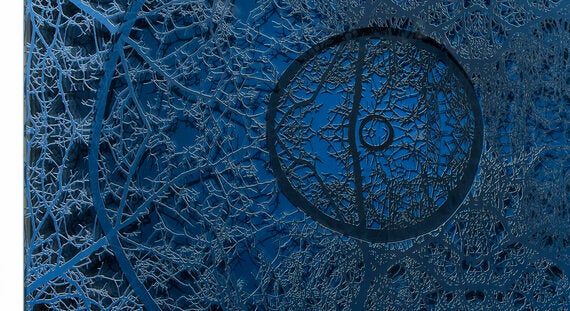
Artist Caroline Jane Harris is inspired by the beauty of nature. "It is humans' relationship with nature" she explains, "my work is about traditional skills and modern technology used together; how they contrast each other and complement each other at the same time, which to me reflects our relationship with nature".
The result is astoundingly intricate. Works bursting with engaging detail and an intriguing hint of mystery. As you revel in the stunning detail and admire the mind blowing intricacy, it is hard to believe that the only tools at the artist's disposal were paper and a mortician's scalpel.
I speak with Caroline just as her first solo show Anatomy of the Arboreal, starts its run at London's Scream gallery and I start by complementing her on developing such an original process.
Q Your work is stunning. In a world so saturated with images, you managed to create something completely new.
A Thank you. It started when I was at university I studied fine art printmaking which is very traditional and hands on, process based. I was doing woodcuts, a Japanese technique which I enjoyed very much I loved the cutting and printing process.
I started to change the process to accommodate my obsession for detail. I started cutting into paper directly and get the details I wanted.
Q Your work has a strong element of craft in it.
A I come from a traditional print making background and love the craft side of things. I started using this process at university and perfected it with a great deal of practice.
Q Can you tell us about the process itself?
A I start with an existing photograph, usually inspired by nature, which I manipulate in Photoshop to create a symmetrical image. I print it out and use a mortician's scalpel (ordered especially) to cut through the paper.
Q Do you have a clear idea of the end result or is it left open?
A I have a good idea of the vision behind the piece and the direction in which I am heading, but it is the actual cutting that leads me to the end result, in that sense it is quite open. I always have a clear idea of the overall composition when I start but the cutting out process is lengthy and intricate so is open to movement. When I finish, I place the resulting cut out paper in between pieces of glass and the framers do all the layering for me.
Q You must have a good relationship with your framers
A Yes I do as they play such a crucial part in the layering of the final piece. I discuss the small details with them and they place cut outs in layers for me, which in turn creates the deep 3D like effect. The pieces are actually framed in a 3D box.
Q The framing is in fact part of the process
A Each hand-cut print is placed between glass, suspended, a bit like a fragile specimen and the lattice-like compositions create depth. The pieces are quite big, some are around 100 cm square
so a great deal of care and know how goes into the framing itself.
Q What is people's reaction when they realise how the piece was actually created and the amount of intricate cutting that went into it?
A I am often asked how long it takes to produce. The answer is a few weeks, anything from up to four months; it is slow and in a way obsessive process that requires concentration, repetition and discipline hailing to traditional techniques.
Q Do you use special paper?
A I use archival, matt photographic paper so colours won't fade over time. I experimented with different weights of paper before arriving at the type I use now.
Q Is the work therapeutic?
A Yes, I actually feel like I have a relationship with the piece
Q Is nature your favourite subject?
A Nature has been the overriding theme. I like tree branches and trees in general. I find they represent the structure of things around us. It is more to do with the triangle of humans, nature and technology but I leave it open for people to see what the subject is.
Q you greatuaded in 2009 and already exhibited in the UK, India, Singapore and Switzerland. You were a finalist at the Aesthetica Art Prize and won the Chelsea Arts Club Trust Stan Smith Award. Your work was also selected for the 2014 MTV Re:Define Charity Auction at Dallas Contemporary (in association with The Future Tense and The Goss-Michael Foundation in the US), all remarkable achievements for a fresh graduate.
A It's not easy for art graduates, when you look at the statistics of how many people graduate from art degrees in the country and how many galleries there are and how many "very successful" artists there are it can be a bit overwhelming.
Most importantly the work needs to be strong and distinctive to stand out but you can help yourself through the myriad opportunities to exhibit and meet gallerists/curators/collectors/anyone who's wants to see you succeed. There are also plenty of overseas opportunities which are better suited to some people's aesthetic or style of working.
Anatomy of the Arboreal is at the Scream gallery until the 2nd of August.
